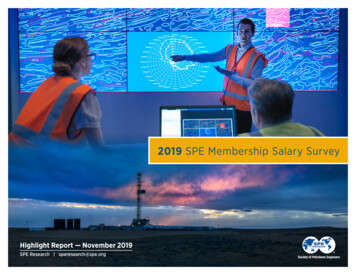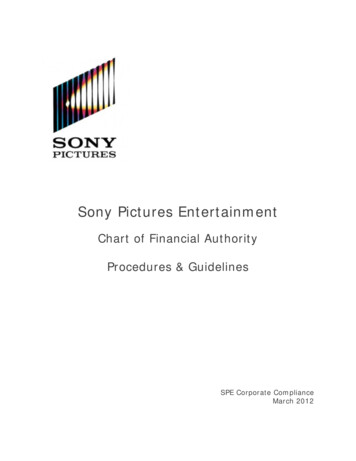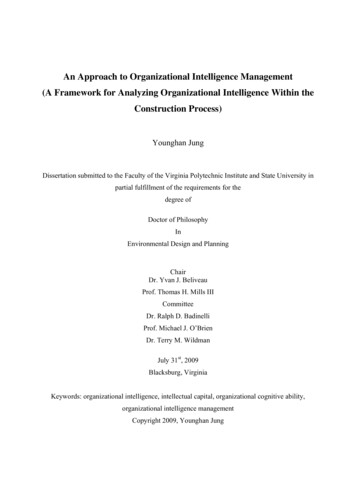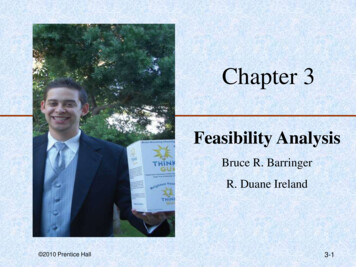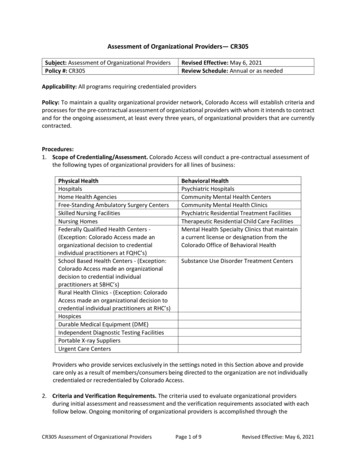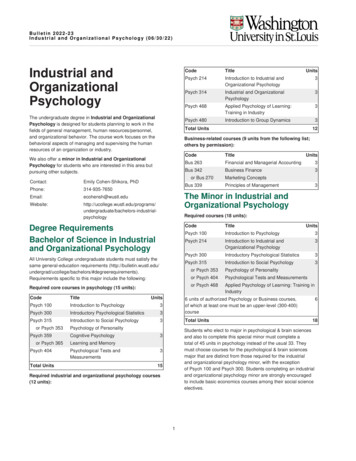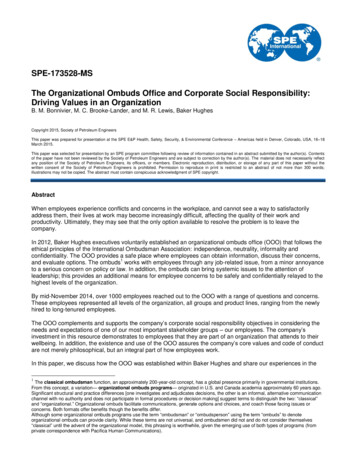
Transcription
SPE-173528-MSThe Organizational Ombuds Office and Corporate Social Responsibility:Driving Values in an OrganizationB. M. Bonnivier, M. C. Brooke-Lander, and M. R. Lewis, Baker HughesCopyright 2015, Society of Petroleum EngineersThis paper was prepared for presentation at the SPE E&P Health, Safety, Security, & Environmental Conference – Americas held in Denver, Colorado, USA, 16–18March 2015.This paper was selected for presentation by an SPE program committee following review of information contained in an abstract submitted by the author(s). Contentsof the paper have not been reviewed by the Society of Petroleum Engineers and are subject to correction by the author(s). The material does not necessarily reflectany position of the Society of Petroleum Engineers, its officers, or members. Electronic reproduction, distribution, or storage of an y part of this paper without thewritten consent of the Society of Petroleum Engineers is prohibited. Permission to reproduce in print is restricted to an abstract of not more than 300 words;illustrations may not be copied. The abstract must contain conspicuous acknowledgment of SPE copyright.AbstractWhen employees experience conflicts and concerns in the workplace, and cannot see a way to satisfactorilyaddress them, their lives at work may become increasingly difficult, affecting the quality of their work andproductivity. Ultimately, they may see that the only option available to resolve the problem is to leave thecompany.In 2012, Baker Hughes executives voluntarily established an organizational ombuds office (OOO) that follows theethical principles of the International Ombudsman Association: independence, neutrality, informality andconfidentiality. The OOO provides a safe place where employees can obtain information, discuss their concerns,1and evaluate options. The ombuds works with employees through any job-related issue, from a minor annoyanceto a serious concern on policy or law. In addition, the ombuds can bring systemic issues to the attention ofleadership; this provides an additional means for employee concerns to be safely and confidentially relayed to thehighest levels of the organization.By mid-November 2014, over 1000 employees reached out to the OOO with a range of questions and concerns.These employees represented all levels of the organization, all groups and product lines, ranging from the newlyhired to long-tenured employees.The OOO complements and supports the company’s corporate social responsibility objectives in considering theneeds and expectations of one of our most important stakeholder groups – our employees. The company’sinvestment in this resource demonstrates to employees that they are part of an organization that attends to theirwellbeing. In addition, the existence and use of the OOO assures the company’s core values and code of conductare not merely philosophical, but an integral part of how employees work.In this paper, we discuss how the OOO was established within Baker Hughes and share our experiences in the1The classical ombudsman function, an approximately 200-year-old concept, has a global presence primarily in governmental institutions.From this concept, a variation— organizational ombuds programs— originated in U.S. and Canada academia approximately 60 years ago.Significant structural and practice differences [one investigates and adjudicates decisions, the other is an informal, alternative communicationchannel with no authority and does not participate in formal procedures or decision making] suggest terms to distinguish the two: “classical”and “organizational.” Organizational ombuds facilitate communications, generate options and choices, and coach those facing issues orconcerns. Both formats offer benefits though the benefits differ.Although some organizational ombuds programs use the term “ombudsman” or “ombudsperson” using the term “ombuds” to denoteorganizational ombuds can provide clarity. While these terms are not universal, and ombudsmen did not and do not consider themselves“classical” until the advent of the organizational model, this phrasing is worthwhile, given the emerging use of both types of programs (fromprivate correspondence with Pacifica Human Communications).
2SPE-173528-MSpreparation and implementation, establishment and operation of the function. We share the range of benefits itbrings to our employees, the company and the broader community as a key component of our corporate socialresponsibility strategy.Corporate Social ResponsibilityThe World Business Council for Sustainable Development defines corporate social responsibility (CSR) as thecontinuing commitment by business to behave ethically and contribute to economic development while improvingthe quality of life of the workforce and their families, as well as the local community and society at large. CSR canalso be thought of as the deliberate consideration of stakeholder needs and expectations in the decisions andactions taken by a company. As the needs and expectations of a company’s stakeholders evolve, so must theCSR strategy change in response. CSR is supported by the concept of sustainable development – finding thebalance between social, environmental and economic benefits. Achieving this balance is fundamental toorganizational growth and prosperity.Corporate stakeholders are those people or groups that have an interest in the activities and performance of acompany. They include customers, investors, policymakers, non-governmental organizations, communities andemployees. Stakeholders expect companies to manage the social and environmental risks and impacts of theiroperations in a responsible and ethical manner, and be a positive force within the community.Employee stakeholders are key in developing, manufacturing and delivering a company’s products and servicesto its customers around the world. A well-trained, motivated workforce has a positive impact on an organization’sability to attract and retain business. In addition, it is often the decisions and actions of the employeesdemonstrating daily commitment to CSR that build a positive reputation and help a company earn its license tooperate.Organizational Ombuds OfficeAs defined by the International Ombudsman Association (IOA), an organizational ombuds (ombuds) is “adesignated neutral who is appointed or employed by an organization to facilitate the informal resolution ofconcerns of employees (and) managers of the organization. The primary duties of an ombuds are 1) to workwith individuals and groups to explore and assist them in determining options to help resolve conflicts,problematic issues or concerns, and 2) to bring systemic concerns to the attention of the organization forresolution.” The IOA’s Standards of Practice and Code of Ethics (SOPCOE) establish four important ethicalprinciples for ombuds: independence, neutrality, confidentiality and informality.Both ombuds and human resource (HR) professionals operate in the people side of business, and there can besome confusion about the roles and responsibilities of each, and even questions concerning the need for both.Initially, the human resources and ombuds roles seem quite similar; however, these two roles are very different.HR professionals serve as part of the management of an organization, with direct responsibility for acquiring andmanaging talent, developing policies and programs, overseeing certain legal responsibilities such as equalemployment opportunity, equal pay and recordkeeping. In addition, HR is an important formal channel, whereemployees can lodge complaints and request investigation of concerns. Such complaints to HR are officiallyplaced on the company’s radar and automatically notify the company of the concerns. The nature of the HRfunction as a formal channel for reporting purposes and the many management responsibilities prevent an HRprofessional from being able to offer confidentiality to employees. HR professionals cannot serve as neutrals, as “their function includes directly representing and protecting the interests of the company” (Bensinger et al). Incontrast, the ombuds can and must ensure complete confidentiality; moreover, as a designated neutral, they haveno vested interest in the outcome of an issue.Synergies between CSR and OOOAguinis and Glavas, experts in the realm of organizational behavior, argue that to realize the full range of value, aCSR program must be embedded into an organization’s strategies, routines and operations. An embedded CSRprogram relies on an organization’s core competencies. In contrast, peripheral CSR strategies that rely on effortsoutside of the core competencies (e.g., volunteering and philanthropy) are less successful as they are not aslikely to instill a sense of meaningfulness and purpose that employees seek through their company and their jobroles. When CSR is embedded in an organization’s core competencies, it has a positive effect on employees such
SPE-173528-MS3as enhancing organizational commitment, organizational citizenship behaviors, retention and engagement. CSRtherefore leads to important outcomes for employees, organizations and society.Retention of employees has value for corporations for a variety of reasons. Oil and gas companies makesignificant investments in their employees. Once selected, a field engineer undergoes several months of basictraining, progressing through a competency management program. It is therefore important to make every effortto retain employees, and to understand and wherever possible, mitigate concerns that might cause them toconsider leaving. The OOO is an important aspect of a CSR program which complements and supports CSRobjectives. It supports the needs and expectations of key stakeholders, and addresses key risks within thebusiness - directly by addressing employee concerns, and indirectly in the benefits that the resolution of issuesbrings to external stakeholders including customers, suppliers, business partners and communities (Ulrich 2014).Furthermore, the creation of an OOO is a signal to employees that the organization is as concerned about theirwellbeing as that of other stakeholders.The OOO which aligns itself with the organization’s CSR objectives brings additional value to the organization.The requirement of the OOO to be independent and neutral does not mean the office must be disconnected fromthe rest of the organization. For an OOO to be of the most value to the organization, it must be aligned with theorganization’s mission and values, embedded within the organization’s existent structures, and integrated ornetworked to the organization’s formal functions (Schenck and Zinsser, 2014). Embedding the OOO in the CSR isa clear example of value addition.Driving Values and Adding ValueWhile ombuds are neutral concerning the people they work with and free of vested interest in the outcome ofissues, an ombuds is focused on promoting certain values, such as fairness, equity and accountability. Theombuds operate following IOA’s Standards of Practice and Code of Ethics (SOPCOE) to ensure their work alignswith both society and company ideals, reinforcing behavior expected within the organization and encouraginggood citizenship. Not only does the work of the OOO add value to the employee and the organization, but it alsodrives corporate values. At Baker Hughes, first and foremost this includes the company’s long-established andwell-embraced core values of integrity, teamwork, learning, performance and courage. The existence and use ofthe OOO further assures that these core values are not merely philosophical, but an integral part of how theorganization works. Integrity. Operating with integrity is critical to the ombuds in establishing confidence and trust with theemployees who call them. In addition, the structure of the office supports its functional independence andintegrity. The OOO helps foster an ethical workplace by working informally, independently, neutrally andconfidentially. In this way, employees can speak with an ombuds in confidence and trust that the ombudstakes no side, but advocates for a fair process, supporting the resolution of concerns.Teamwork. Teamwork leverages individual strengths in the pursuit of common goals. The ombuds workstogether with an employee to identify possible solutions and strategies to address an issue. Often amongthe options is taking a team approach within the workplace to develop a solution.Learning. The OOO promotes learning for both the employee and the organization as a whole. Theombuds routinely informs and guides employees on policies, procedures and processes. Working withemployees to assist them in resolving conflicts results in a workforce better equipped to dealindependently on future issues that arise. In addition, the OOO identifies recurring themes and trends andshares these with leadership, enabling leadership to take appropriate corrective action.Performance. As employees who work with the OOO successfully resolve their concerns and issues,they are empowered to move forward with more focus and be more productive.Courage. It takes courage to take ownership of challenges, even those that appear insurmountable, andto stand for what is right. Employees who feel they have been unfairly treated may be reluctant toapproach their management or an HR professional for fear of retaliation or embarrassment. The need forcourage also extends to management and leadership, because it is important to listen openly andrespond appropriately when concerns are brought forward, especially when such responses are difficultor involve risk. The OOO guarantees complete confidentiality and enables a safe sounding board for bothemployees and managers to identify and evaluate options.The broader benefits of the OOO to the employee, the company and to society include improvements in thefollowing areas:
4SPE-173528-MS Communication. Vocalizing concerns and being able to discuss them with an ombuds in a safeenvironment can bring tremendous relief to employees who do not know where to turn. The ombuds canhelp employees better articulate their complaints or expectations. In addition, common issues arecommunicated in an anonymous way to the highest levels of the organization where they may not havepreviously been recognized.Alignment of objectives. The OOO works to align employee perceptions with the organization’s identityby addressing misconceptions that lead to conflicts in the first place. Clarifying cultural differences,helping parties see other sides in a dispute and educating an employee or manager to become moresensitive to diversity are examples of the valuable contributions an ombuds can make to an organization.Systems and processes. An individual complaint can be the catalyst for an analysis of systemicdifficulties and may be the first step in implementing improvements and efficiencies into establishedsystems of work. An OOO is a supplement to the existing formal channels, and the office does not makethe improvements; the OOO does not have the power to make such changes. As an embedded andintegrated resource, the office can serve as a conduit to the formal channels that can respond to suchsystemic issues and amend processes as appropriate.Employee engagement. Employees who are more engaged with their work have higher morale, aremore productive, have a more positive influence on those they work with and are less likely to leave thecompany. They also demonstrate the ethical and responsible behaviors expected of the company by itsstakeholders. The work of the OOO in resolving conflicts helps to foster a culture of proactiveengagement where employees are involved and enthusiastic about their work and feel a strongconnection to the company.Workplace relationships. One of the most common issues addressed by the OOO is workplacerelationships, particularly between the employee and their manager; these relationships are by natureunequal, because the supervisor has responsibility and control over performance reviews, salarydecisions and many aspects of future career opportunities. The ombuds is therefore a regulatory agent inthis power relationship, with respect to certain values (Rowe, 1995). Often the ombuds focuses onbalancing these relationships by working through these sensitive issues with the employees, helping themdevelop appropriate strategies with integrity.Reduced legal costs. Ignoring conflict within the workplace can be costly. The OOO can help addressissues before they escalate to a more serious situation, potentially leading to an employee taking legalaction.Reputation. Ultimately, a company’s objective is to be recognized as a good corporate citizen. Byaddressing issues and conflicts within the workplace, employees become more engaged and thus betterambassadors for the company, leading to a good reputation among stakeholders. The many benefits of agood reputation include attracting investment, top talent and new business, as well as earning ormaintaining a license to operate in various regions around the globe.Participation in society. The ombuds also enables employees to become more empowered within theircompanies and in society. Through their interactions with the OOO, employees gain new skills, tools andinformation to resolve conflict or improve relationships. Knowing how to raise concerns effectively anddiscuss matters in an open, honest way builds trust, improves work environments and contributes to ahealthy society. The ombuds’ daily contribution to employees brings a continual reminder of thecompany’s commitment to workplace harmony.OOO: Rationale for EstablishmentBy 2008, Baker Hughes had operated for over a century as a number of independent companies. Each companyrepresented a division of Baker Hughes and had its own unique culture, practices, policies and programs. Overtime, some aspects of the business were harmonized, but in reality, each division still operated more or lessseparately. Most major decisions were made at the divisional headquarters in Houston, TX.Over time, the nature of the oil and gas industry evolved and new hydrocarbon discoveries were increasinglyfound far from the United States. The client base included more national oil companies and independents as wellas the more familiar international oil companies. Baker Hughes leadership determined that to better serve thediversity of clients, the company structure had to change. In 2009, the organization transformed from eightseparate global divisions to an integrated, geographically based corporation. There are now four operatingregions, comprising 25 geomarkets, which function with local teams working to understand customer needs andcoordinate the delivery of solutions, incorporating the technology of all the product lines and required services.Manufacturing and supply chain operations were separated from the front line operational units and consolidated.
SPE-173528-MS5Technology development and technical training were also centralized.Also at this time, the company completed a major acquisition, adding new product lines previously outside itsscope and increasing the number of employees by 15,000. Company cultures and histories varied, as did manyprograms and career development processes. Most formal and informal communication networks weredismantled; policies and programs were evaluated and harmonized. Such dramatic change in a short period oftime can create challenges for employees. This was proven in employee engagement surveys conducted in 2010and 2011, where employees indicated they felt disconnected from senior leadership and were unsure where thecompany was going.A number of actions were taken by leadership to increase employee engagement, including the voluntaryestablishment of an organizational ombuds office.Preparation and ImplementationIn 2010, the chief legal and human resources officers of the company began discussing the concept of an OOOwith an external consulting group with expertise in the functions, benefits and establishment of OOOs.Presentations made to executive leadership demonstrated the potential value an OOO can bring to theemployees using the service, as well as to the organization, which can benefit from protected, unfiltered feedbackfrom those employees. Consultation with various internal stakeholders followed, providing the first opportunity forthe external consultant to begin learning the culture, history and needs of the company, as well as tocommunicate the concept of an OOO to a larger cross-section of the organization. A number of senior executivesparticipated in a benchmarking process arranged by the external consultant, speaking to leaders of severalcorporations with well-established OOOs. The learnings from these meetings further proved the potential valuesuch an office can bring to an organization undergoing such dramatic change and growth. Early on, thecompany’s executive leadership anticipated the ombuds office would add value and naturally complement thecompany’s corporate social responsibility objectives for employees. Executive leadership set out to establish anombuds office with this value proposition in mind and in a way that best supports the OOO’s success.The design and buy-in phase of the project occurred in late 2011 through mid-2012. The office was designed toattentively respond to employee concerns, intentionally embrace strategic changes made in the company, andcarefully align with the company’s core values and important internal objectives. A team of employees fromacross North America, representing various business segments, grade levels, lengths of tenure and backgrounds,provided insights into company culture and business realities. In the process, the members gained early learningsof the OOO concept, which they were able to begin informally seeding throughout their parts of the organization.Next, leaders of key business segments and various support functions formed a committee to oversee thedevelopment and finalization of the key documents establishing the OOO, ensuring alignment with both thecompany's values as well as adherence to the IOA’s SOPCOE. Facilitated by the external consultant, thiscommittee approved the o3 moniker for the organizational ombuds office ("ombuds" was difficult to pronounce)and the o3 logo (using green to stand out from the company's blue), an initial communications plan, andcorresponding materials. They also participated in hiring and onboarding the OOO staff, and supported theprogram’s integration within the company.The external consultant identified organizational needs and goals to form the OOO's charter. The project design,including program architecture, and communication and implementation plans, balanced these needs with theSOPCOE requirements. This approach fostered the program's alignment, embedment and integration (AEI),which best affords an effective launch and sustainable usage. These program elements included a staff positiondedicated to working with the OOO data; oversight committee comprising members from various functions; arobust communications plan, use of a variety of vehicles to inform managers and employees, and a charter andpolicy which threaded the program within the company. Their expertise and behind the scenes leadership in thedesign and building of the program safeguarded the OOO staff's neutrality. For example, at the time the programwas developed (which occurred nine months in advance of staff hiring), the company had a policy prohibitingspecial logos. The external consultant made the case that for the program to be noticed and its unique statusappreciated, it needed a logo that distinguished it from other company offerings. While at first glance this mayseem insignificant, the branding and recognition of the new function is integral to gaining awareness andunderstanding, as well as symbolizing the OOO's unique role in the company. This and other specialrequirements needed for an AEI and IOA SOPCOE-compliant program, such as independent communicationssystems, were topics the external consultant negotiated.Prior to finalizing the program's charter and policy, the external consultant met with the leaders and senior
6SPE-173528-MSmanagers of several formal functions, including health, safety and environment, legal and human resources.These initial meetings were critical introductions in advance of its launch to present how this supplementalfunction operates and the purpose it serves, as well as to build greater awareness, understanding, acceptanceand trust. These meetings covered data sharing, reporting structure and areas of overlapping responsibilities, andlaid the foundation for the future interactions between the OOO and these formal functions, thus developingintegration. The external consultant also worked with the communications department to develop pre-launch website content, including a video statement from a senior leader, which provided additional information andresources for those leaders and managers interested in learning more. A frequently asked questions documentwas sent to managers prior to the launch, to familiarize them with the concept before the OOO started.The external consultant also developed the content for the implementation communications plan, includingbrochures, posters and a mailing from the CEO sent to each employee's home. Having these pieces and otherprogram components in place enabled the OOO staff to be ready to accept cases as soon as the programlaunched.EstablishmentIn the summer of 2012, the OOO was staffed to create a team that embodied the necessary skills and experiencein both workplace conflict management and the company’s business operations and culture. Together, the teamrepresented a balance of individuals with more than fifty combined years of service in various roles from within thecompany as well as external hires with prior experience in the field of conflict resolution. The combined strengthsand perspectives empowered the team with a well-rounded appreciation for the challenges it faced in bringing thecompany’s concept of an ombuds office to life.As the team launched the OOO, they witnessed puzzled, confused expressions as they described their line ofwork. The team understood they were introducing a foreign concept to nearly thirty thousand employees acrossNorth America. They knew they needed a comprehensive strategy to introduce the OOO beyond the Houstonbased leadership to other geographic parts and all levels of the organization and, therefore, followed theimplementation plan which addressed details of branding, communications, oversight, office space, protocols andcase tracking.To ensure functional independence, the OOO reports to the chairman and chief executive officer of the company.This reporting structure establishes a separation from formal channels such as human resources and legal.Interests from the human resources and legal functions are appropriately heard through an oversight committeethat was deliberately designed for the OOO to provide support and connectivity. The chief legal and humanresources officers of the company are members of this oversight committee, along with executives from corporatestrategy, operations and finance. To ensure that the oversight committee also connects more directly withemployees, two committee members are managers from deeper within the organization with direct reports on thefront line. In this way, the oversight committee purposely includes the voice of the employee. These processesand the committee's responsibilities are outlined in the OOO's charter and referenced in their policy. The OOOmeets quarterly with the oversight committee to report on activity in the office and provide high-level reportsconcerning trends and systemic concerns.The physical office space for the ombuds office was designed to address a number of important interests, someof which at times seemed in conflict. Employee access to the office might have suggested placing the physicaloffice space in a large company facility housing thousands of employees. Employee concerns for confidentialityand privacy, however, ultimately guided the o3 team in selecting office space that was near, but not on, companyproperty. In this way, local employees wanting to meet with ombuds in person can do so privately. The office isequipped with adequate security systems and designed to create an environment that is welcoming. The OOOavoided using the company’s common office design standards to underscore the neutrality and independence ofthe office.The team developed protocols for office operations, captured in handbook form. With an aim to developconsistent and repeatable standards, the handbook contains all elements of the office’s operations including suchmatters as case intake and scheduling, confidentiality considerations, methods for referral or follow up, datamanagement, document destruction, user satisfaction, and measurement and evaluation. The handbook is aliving document, regularly updated to capture continuous improvement in office operations and guidelines forstandard operating procedures.
SPE-173528-MS7For successful case tracking, the team utilizes a database tool to identify the essential issues that employeeswere bringing forward. The tool, designed by former ombuds for use in OOOs, balances the ability to trackactivity, develop metrics and identify trends with the need to ensure that no information is kept that could identifycallers. Beginning with the uniform reporting categories (URC) promulgated by the IOA, the team refined twoadditional layers below those categories. By aligning with the IOA’s nine categories, the team retained connectionwith the IOA and other OOOs to allow the organization to compare the breakdown of issues with otherorganizations, and to share learnings with peer ombuds at other institutions. By adding refinement within the ninecategories, the team is able to capture the employee concerns unique to the c
This paper was prepared for presentation at the SPE E&P Health, Safety, Security, & Environmental Conference - Americas held in Denver, Colorado, USA, 16-18 March 2015. This paper was selected for presentation by an SPE program committee following review of information contained in an abstract submitted by the author(s).


